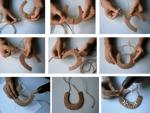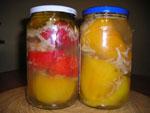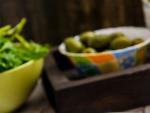What to do if you come across a not very wormy porcini mushroom? How to peel mushrooms quickly and correctly? Appetizing boletus mushrooms, chanterelles and champignons are a decoration for any dish. What to do with worms in mushrooms.
We are not the only ones who appreciate mushrooms. Every forest creature loves them, both running, flying and crawling. And living in the mushroom itself. Today we’ll talk about them, who take away our spoils. Insects, by the way, benefit mushrooms more than people - worms eat the mushroom and carry the spores into the ground, thereby helping the mycelium spread.
But what to do with wormy mushrooms? Throwing it away is a pity, leaving it is scary, in case we get poisoned... Let's figure it out.
Where do worms come from in mushrooms?
Worms, that is, insect larvae, hatch from eggs laid different types flies and fungus gnats. Some live in an apple, some in a raspberry, and some mushrooms I like it better. Thicker and tougher worms are found in mushrooms - wireworms (larvae of click beetles). Insects prefer to fly when it is dry and sunny, so the likelihood of encountering a wormy mushroom is higher in good weather.
Is it possible to get poisoned by wormy mushrooms?
Yes, if this mushroom is poisonous. There is a myth that worms do not grow in poisonous mushrooms. This is a dangerous misconception. Very tasty and completely safe chanterelles and hedgehogs are not wormy. On the other hand, pigs easily worm, which cannot be eaten without boiling.
Themselves worms do not make the mushroom poisonous. Speculation that one can be poisoned by “worm waste products” has no basis. Do you know what propolis is? — That’s right, also a product of the vital activity of an insect (bee).
What to do with wormy mushrooms
Three options for your choice:
- Leave the mushroom for the worms to finish eating. At least let them be happy. This is what I do with heavily wormy, already rotten mushrooms. You can throw their caps under the trees at the dacha, maybe a mycelium will start.
- Pretend we didn't notice them.
- Drive out of the mushroom. There are two ways to expel it: soak the coarsely chopped mushroom for 1-2 hours in salt water. Or dry the mushroom. As soon as the mushroom begins to wilt, the worms will fall out of it. Don’t forget to sweep the floor in time, otherwise you won’t scare someone...
What don't do with wormy mushrooms
Do not under any circumstances talk about what you saw at the table. inside mushroom. Suddenly, there are vegetarians next to you... Seriously, in fried mushrooms the worms are invisible in appearance, and even more so in taste. Problems are possible with mushroom noodles or soup. A worm can emerge from the broth at the most inopportune moment - on the plate of a respected guest, for example. To avoid unpleasant surprises, it is better to filter the broth.
And for dessert, I offer you an excerpt from Vladimir Soloukhin’s wonderful book “The Third Hunt,” which I read a lot as a child.
You admire your find, but your soul is restless. He is beautiful, but he can be eaten by a worm. You cut it, and inside there is rot, or if not rot, then everything is filled with countless holes and tiny white worms. You'll be in last hope cut off the white wheels from the root: maybe there are no worms closer to the cap. This is the last cut, close to the cap, but even here there are wormhole holes. All that remains is to cut the cap itself. You cut it and throw it on the ground. The prey, it turns out, is not yours. Even earlier, nasty forest flies found that mushroom and made it their prey, laying eggs, from which even more nasty forest worms now hatched.
Every lover of “silent hunting” is familiar with wormy mushrooms. The nutritious gifts of the forest are loved not only by people, but also by insects that lay eggs on them. These mushroom hunters are often ahead of humans.
A late mushroom picker gets mushrooms eaten away by worms. Considering that every mushroom is obtained through hard work, it’s a shame to throw them away. Maybe it can be somehow cleaned of worms and used for food - we’ll look into it further.
Why do mushrooms become wormy?
Special insects, fungus gnats and flies, lay eggs on fruit bodies that have just emerged from the ground. IN warm weather The eggs quickly mature and larvae emerge from them. They feed on mushroom pulp, grow, turn into adult insects and fly away.
The mycelium does not suffer in this case. On the contrary, the larvae help move spores into the soil from the bottom of the cap. The mycelium becomes more viable and increases the number of mushrooms.
The mushroom picker gets upset when a young, delicious fresh boletus or saffron milk cap, just cut sharp knife, turns out to be wormy. It is believed that wormy mushrooms are unfit for food and their only purpose is to be thrown away.
In fact, the worms in the mushroom are not dangerous to human health. They do not make the mushroom poisonous. Wormy mushrooms are edible. The only difficulty is that no one will like it if there is a pickled or fried worm on his plate.
The most experienced mushroom pickers know how to avoid such trouble. There are ways to process wormy mushrooms, which allow you to compete for forest finds and ensure that they end up on the dinner table. The main thing is that the mushroom is not rotten or rotten.
It is better to throw away the old wormy mushroom. Not because he is wormy, but because he is old. This product contains many harmful substances. If you sniff an old boletus or aspen boletus, even one that is not wormy, you can smell the smell of ammonia. But young, strong, not very wormy, fruiting bodies without signs of decomposition are suitable for food.
For industrial harvesting, mushrooms that are less than half infested with worms are considered edible.
What to do with wormy mushrooms
Worms can live in both the stems and caps of mushrooms. If you cut an aspen boletus and look at the cut, most likely it will be fresh, without holes. But if you break its cap, you can see many holes in which microscopic larvae sit.
Are poisonous mushrooms wormy?
We can say that almost all mushrooms in the forest are wormy, even if the holes in the stem or cap are invisible. It’s just that each mushroom is at its own stage of worminess - noticeable or invisible. Young dense formations are damaged more slowly than old and loose ones. But in the wet hot weather even young mushrooms are rapidly colonized by larvae. It seems that they are already emerging from the ground, eaten away.
Everyone is familiar with the appetizing and tasty chanterelles. Having found a clearing covered with chanterelles, you can safely cut off all the specimens in a row. Before placing them in the frying pan, you only need to wash them off the soil and blades of grass.
Some mushroom pickers are very mistaken in believing that worms do not attack poisonous mushrooms. Most of them are tasty food not only for worms, but also for snails. By the way, fly agarics and toadstools do not have a bitter taste or unpleasant odor and are often damaged by worms.
Surely each of you, being a child, has heard that there are worm-like mushrooms. The adults insisted not to eat or even try to pick them up. Their fears were not in vain. Parental DO NOT is confirmed by the opinions of scientists and experts.
A tasty and dangerous morsel
Rarely will a person refuse to eat mushrooms and ask: “why not?” This culture grows all over the world and is loved a large number people. However, besides us, there are other connoisseurs of their appetizing properties. Worms. Here are those who enjoy tasting and living inside what they think is an edible house. In this they help the “devil meat” to carry spores and, literally, to propagate the mycelium. The smallest pests and microorganisms feed and at the same time help fungal families survive. They simply cannot cope without their indispensable participation. They will die.
Insects are found quite often in mushrooms. Both poisonous and edible. Especially in good warm and sunny weather. Hard larvae of beetles, flies, mosquitoes and other invertebrates do not harm their home. But they can have a much more negative and sometimes even lethal effect on human health. Poisoning is the first sign that you have eaten a contaminated product. Therefore, carefully avoid such delicacies. Do not collect them and do not eat them under any circumstances. Don't become a new home for these creatures. After all, this is also not excluded. And this is a very compelling argument in favor of why you should not eat wormy mushrooms.
Rehabilitation of worm fungus
The easiest way to get rid of this problem is to throw out the infected mushroom. Cut off the fried parts, boil in several waters, pour in acetic acid, dry-salt, or put the caps under the bushes in the country with the thought that someday you will grow mushrooms in your own area - the choice of alternative depends on your responsibility and attitude to your health.
Unfortunately, or fortunately, modern cooking does not know methods for preparing dishes with such an extreme composition. Wormy mushrooms will not please any sane gourmet even with the most discerning taste. And one last piece of advice. Never bring up the topic of wormy mushrooms while sitting at the table. Not all your guests will understand the meaning of your words if you serve freshly collected and cooked wild mushrooms.
Bon appetit to you!
The white ones have been in the refrigerator since Sunday, unprocessed)) I took them out now, and there were white worms in them.. brrr..
- Lots, lots, lots of meat in mushroom sauce. To rid mushrooms of worms, you need to soak them (mushrooms) in salt water. The worms will come out and float to the surface. They will leave the mushrooms.
- There will be mushrooms with meat.
- nothing means edible
- Place in salted water, but in general mushrooms are a delicate product. they need to be processed immediately.
- You'll probably get poisoned. But it can also be like in fruits - wormy means good, tasty)))))
- You should be afraid of worms, not which you eat, but which will eat you :)))))))))
- nothing will happen...)))
No one has died yet.
They sell no better in stores!
Pavel Sokolovsky: notes for mushroom pickers, part 3
How to take mushrooms correctly: cut or twist?
This is a sore point. There are mushroom pickers here, so many opinions. Here's what the doctor writes about this: biological sciences L.V. Garibova: “Mushroom pickers are often concerned with the question: how to properly collect mushrooms - cut or twist? The answer is simple: mushrooms should be collected, whichever is more convenient. Tubular mushrooms are easier to twist, they have a dense stem, and lamellar mushrooms should be cut off, since their stem is hollow It is very fragile and will crumble if you try to unscrew it. The main thing is not to dig it up. forest floor so as not to damage the delicate thin mycelium located in it. The hole formed after the mushroom has been removed should be covered with earth or bedding. With such precautions, the mycelium in this place will bear fruit repeatedly."
Up...
What to do if the mushroom turns out to be wormy?
If, after cutting a mushroom, you see that it is wormy, you can proceed in three ways.
Firstly, you don’t have to take it at all. In this case, leaving the mushroom on the ground, and even turning the cap upside down, as is sometimes done, is not worth it. Experienced mushroom pickers advise placing the cap of a wormy mushroom on spruce branch, or prick it dry, “spores down.” At the same time, the cap does not rot, but dries, ripens and spreads dust over a large area (you'll see that several new foci of mycelium will appear). In addition, the mushroom dries and in winter, at the most hungry time, it may please some hare, squirrel or bird. Your work is 5 seconds, but the benefits are great. If each mushroom picker gets at least 20-30 “pricks” per trip, then there will be more and more mushrooms.
Secondly, you can cut it into two halves along the entire length from the top of the cap to the end of the stem and see if the entire mushroom has become wormy. If it turns out that the cap is clean, you can cut off the stem and take only two halves of the cap.
Thirdly, you can take the whole wormy mushroom, if it is not completely flabby and old. At home, you need to cut it and put it in highly salted water for several hours (1-2 tablespoons of salt per medium-sized pan). After such a “bath”, all the larvae will crawl out of the mushroom. Then the salt water should be drained and the mushrooms should be washed thoroughly. The disadvantage of this method is that although the larvae crawl out, their waste products may remain in the mushroom.
Up...
How to “reliably” distinguish a non-poisonous mushroom from a poisonous one?
There is only one correct way - to examine the mushroom and determine its type by characteristic features. There are no other reliable methods. However, to reduce risks, it is advisable to remember the following tips:
1. Never collect or eat those mushrooms that have a tuberous thickening at the base of the stem, surrounded by a shell (pale toadstool, fly agaric). Attention: collect mushrooms only with a whole stem, so as not to lose sight of this important sign!
2. Never taste mushrooms or lick them. So you still won’t be able to determine anything, and poison (even in microscopic doses) can cause significant harm to the body.
3. If you have even the slightest doubt about the “edibility” of a mushroom, it is better to throw it away.
4. Try not to pick mushrooms after a long period and hot weather - during drought they lose water, their metabolism changes, which leads to the formation of unpleasant toxins even in noble mushrooms.
5. Do not collect old, spoiled, rotten, soft, overripe mushrooms. The balance of substances in them is disturbed.
6. Don’t trust drawn pictures of mushrooms in books - as a rule, they are far from reality.
(See also the question about external toxins and radiation below.)
There are very dangerous, but, unfortunately, deeply rooted misconceptions about supposedly “reliable” methods of identifying poisonous mushrooms. You need to know them, never use them, and warn your friends and neighbors about the danger.
Attention: the methods below are dangerous to life! They must not be used under any circumstances!
Misconception 1. “Poisonous mushrooms can be identified using a silver spoon or onion.”
Mountain experts say that if you put a silver spoon in a saucepan with soaked mushrooms, then, if there are poisonous mushrooms, the spoon will turn black, and if you put an onion, it will turn brown. This is wrong. This testing method is similar to checking a gas leak with a burning match - it works until the first (and last) explosion.
Misconception 2. “Insects do not eat poisonous mushrooms”
Allegedly, if a mushroom is thoroughly gnawed by a snail, this indicates its suitability for food. This is wrong. The human body is very different from the insect body, and what is suitable for snail food can be deadly for humans.
Misconception 3. “Poisonous mushrooms become edible after salting or pickling.”
This is completely untrue. Pale grebe can send you to the next world both in salted and pickled form.
Misconception 4. “The poison from mushrooms can be removed by boiling them for several hours.”
This is a dangerous mistake. The poisons of most mushrooms are heat-resistant and it is impossible to turn a toadstool into a honey fungus by boiling.
Up...
Wormy white mushroom
Description:
It also happens: you see a beautiful porcini mushroom, you will get it out of the earth, and its beauty and taste qualities our competitors have already appreciated the worms. It's a shame, the mushroom is young and strong and has already been completely eaten away. In such cases, I unscrew the stem and (if the cap is not very touched by worms) I take the mushroom. For drying, it’s even okay. The photo shows the side of the mushroom stalk eaten away by worms.
Dimensions: 640 x 480 File size: 62.65 KB
Rpu6o4ku: why don't most people eat wormy mushrooms?
- Create an account
- Explore
Wormy mushrooms - hunting and fishing - hunting - forum on kuban.ru
Ducky
")">1- 08.06.2012 - 11:05
It all depends on how wormy the mushroom is. If the old one is wormy, then definitely throw it away. But if they are strong, then it’s not worth it. I cut them up and let them dry, the worms fall out on their own and I get beautiful dried mushrooms. In warm weather, mushrooms are often worm-eaten. So there may not be any protein at all.)
")">2- 08.06.2012 - 11:40
1-Ducky >and so do we. Only for drying it is better to lay them out on some kind of hole-lattice surface. Most of the worms (uncut) will fall out. You can probably try the method - on the way back from Mezmay we collected some and put them in bags. It was hot in the car, and when I looked into the bag of mushrooms, all the worms had come out and were sticking out from the bottom of the cap, like cloves that were steamed in the bag. It would be very easy to remove them at this point. Aquarium fish love them very much. If they are mushrooms, it is very unpleasant when missed worms swim along with the mushrooms. Most can be removed by rinsing in a colander with large holes. So don't throw it away next time
Dr_Nick_Riviera
")">3- 08.06.2012 - 12:17
Thanks for the answers.
Yes, in principle, to hell with them and worms (I’m not squeamish).. can you get poisoned from such mushrooms (if you don’t dry them, or boil them)?
Ducky
")">4- 08.06.2012 - 12:59
2-opal >And I’m over the gas stove, drying, stringing. So they fall out on the stove, I then sweep them up and... throw them away, there are no fish.)
3-Dr_Nick_Riviera >Yes, there seem to be no consequences. People joke “mushrooms with protein, delicious”) But I don’t really like floating ones. When frying, you really can’t see them :) But the very fact that I know that they are there stops me :))) So, only if I’m very hungry then I forget and eat.)
Mitusov Evgeniy RZ6AVM
")">5- 08.06.2012 - 13:10
Not the worms that we eat, but the ones that eat us!!!
viktorovic
")">6- 08.06.2012 - 20:16
5-Mitusov Evgeniy RZ6AVM > Don’t be too creepy, otherwise the question will follow: “Won’t mushroom worms eat someone from the inside...?”
I think that everything depends on the degree of damage to the fungus by larvae, and on the method of processing. And depending on what kind of mushroom it is. I don’t need a wormy one at all, but if the white one is slightly touched by a wormhole, it will go for drying....
")">7- 09.06.2012 - 08:14
3-Dr_Nick_Riviera >if the mushroom is not old and not eaten away like a sieve, it smells nice, then it’s okay. For me too, you’ll pick mushrooms, and even before you bring them home (the worms eat them with incredible speed, it seems like when I cut them off, there was nothing, until I got it, some kind of bad thing, and the smell was spoiled). out of 10, one or two remain. You can cook it, not necessarily just for drying
Panda
")">8- 09.06.2012 - 13:11
Dip the mushrooms into salt water, after a while the worms will appear at the bottom of the basin.
Mirror
Moderator
")">9- 10.06.2012 - 13:04
Summary: of course it’s better without worms because... You can also be seriously poisoned by a wormy fungus - the waste products of the worm. BUT(!!!) I, like everyone else, sometimes take wormy ones. There are only two rules for collection and processing:
1 already said by Irisha Opal: smell. If the wormy mushroom smells good, it means it has not yet had time to deteriorate. You can take it. At home you will still have to smell it to see if it has spoiled on the road.
2 already said by Panda. If the mushroom is not to be dried, it is filled with very salty water. All the worms run away :) Then you can fry, boil, preserve: there are no worms in such mushrooms anymore :)
Pekubo
")">10- 10.06.2012 - 21:46
8-Panda > Thanks for the advice, today I filled the entire catch with salt water, it really helped!)) The mushrooms are almost clean, but there were some larvae, they all settled in the basin.
")">11- 25.08.2012 - 15:38
I adopted salt water. But drying mushrooms without preliminary heat treatment is a risky thing. After the mushrooms have turned to dust several times without having time to dry, I preheat them until boiling bubbles appear in the oven.
")">12- 27.08.2012 - 12:56
11-Remake >they dried out for me literally within a day under a fan directed strictly at them (which I did not turn off)
Mirror
Moderator
")">13- 27.08.2012 - 16:32
If wormy mushrooms are dried, then they will still spoil, no matter how quickly and at what temperature they are dried: in winter, larvae come to life in them and midges hatch. I have lost so many dry preparations, now I don’t risk drying the wormy ones. It’s better to freeze such mushrooms.
")">14- 27.08.2012 - 22:13
Wormy mushrooms should not be consumed, because... it does not contain protein worms, which the natives eat on both cheeks, but more toxins, their waste products (toilet, etc.), so you decide what to eat - a house for worms or mushrooms.
Ducky
")">15- 29.08.2012 - 09:53
Yesterday everything disappeared again.
It’s not worth eating heavily wormy ones, that’s one hundred percent.
But since there are few pure mushrooms in the summer, it is natural that slightly wormy mushrooms are taken by almost all mushroom pickers.
May the mushroom gurus forgive me, but when hot dried in mushrooms, the larvae will not be able to come to life, they will bake.
I only freeze mushrooms that are not wormy, I don’t like to eat with worms, and then salt water won't help. And the slightly wormy ones go to drying. The worms all fall out. BUT I dry it with hot air, over a gas stove and in an electric dryer. During the time I dried the mushrooms, they never rotted and there were no insects of any kind. Dried mushrooms I store it in glass jars, closed with a nylon lid. They are stored for two years. Once I had a 1.5 liter jar sitting there for three years and forgot about it. Everything is fine, no rotten parts and no insects.
Panda
")">16- 29.08.2012 - 18:20
15-Ducky. I agree, the larvae are unlikely to come to life, then the moth will start if not in a jar.
Wormy mushrooms. To eat or not to eat - that is the question...
We are not the only ones who appreciate mushrooms. Every creature loves them, both running, flying and crawling. And living in the mushroom itself. Today we’ll talk about them, who take away our spoils. Insects, by the way, benefit mushrooms more than people - worms eat the mushroom and carry the spores into the ground, thereby helping the mycelium spread.
But what to do with wormy mushrooms? Throwing it away is a pity, leaving it is scary, in case we get poisoned... Let's figure it out.
Where do worms come from in mushrooms?
Worms, that is, insect larvae, hatch from eggs laid by various types of flies and fungus gnats. Some live in an apple, some in a raspberry, and some mushrooms I like it better. Thicker and tougher worms are found in mushrooms - wireworms (larvae of click beetles). Insects prefer to fly when it is dry and sunny, so the likelihood of encountering a wormy mushroom is higher in good weather.
Is it possible to get poisoned by wormy mushrooms?
Yes, if this mushroom is poisonous. There is a myth that worms do not grow in poisonous mushrooms. This is a dangerous misconception. Very and completely safe chanterelles and hedgehogs are not wormy. On the other hand, pigs easily worm, which cannot be eaten without boiling.
Themselves worms do not make the mushroom poisonous. Speculation that one can be poisoned by “worm waste products” has no basis. Do you know what propolis is? — That’s right, also a product of the vital activity of an insect (bee).
What to do with wormy mushrooms
Three options for your choice:
- Leave the mushroom for the worms to finish eating. At least let them be happy. This is what I do with heavily wormy, already rotten mushrooms. You can throw their caps under the trees at the dacha, maybe a mycelium will start.
- Pretend we didn't notice them.
- Drive out of the mushroom. There are two ways to expel it: soak the coarsely chopped mushroom for 1-2 hours in salt water. Or dry the mushroom. As soon as the mushroom begins to wilt, the worms will fall out of it. Don’t forget to sweep the floor in time, otherwise you won’t scare someone...
What don't do with wormy mushrooms
Do not under any circumstances talk about what you saw at the table. inside mushroom. Suddenly, there are vegetarians next to you... Seriously, worms in mushrooms are invisible in appearance, and even less so in taste. Problems are possible with mushroom noodles or soup. A worm can emerge from the broth at the most inopportune moment - on the plate of a respected guest, for example. To avoid unpleasant surprises, it is better to filter the broth.
And for dessert, I offer you an excerpt from Vladimir Soloukhin’s wonderful book “The Third Hunt,” which I read a lot as a child.
You admire your find, but your soul is restless. He is beautiful, but he can be eaten by a worm. You cut it, and inside there is rot, or if not rot, then everything is filled with countless holes and tiny white worms. You will be in your last hope to cut off the white wheels from the root: maybe there are no worms closer to the cap. This is the last cut, close to the cap, but even here there are wormhole holes. All that remains is to cut the cap itself. You cut it and throw it on the ground. The prey, it turns out, is not yours. Even earlier, nasty forest flies found that mushroom and made it their prey, laying eggs, from which even more nasty forest worms now hatched.
But when you cut the mushroom close to the ground and see that the meat of the root is as white and pure as sour cream or lard, then your heart will skip a beat for the second time. And it turns out that you found one mushroom, as it were, twice, and experienced double the joy of hunting from it.The second most important mushroom is nigella, or milk mushroom. This mushroom is not particularly suitable for frying, only as an additive, due to its pungent taste. But, soaked and salted, it is a rare delicacy with extraordinary deliciousness. This fungus is especially good with potatoes, and you can pour a glass with such a snack! Black milk mushrooms are collected in the fall - during this period the forest is especially magnificent - there is no summer stuffiness, the air is filled with the smell of flying leaves. Behind the black milk mushroom is pleasure. You just need to take a stick. The fruiting bodies of the mushrooms are hidden under fallen leaves, often near the very trunk of birch trees (nigella has a symbiosis with birch); they are dark, earthy in color. It can be quite difficult to notice them. Main -
take a closer look and pick up as much as you need for salting. And how pleasant this mushroom is to the touch - cool, with a rough cap, with reverse side covered with droplets of milky juice, tart smell.
The third most important mushroom is boletus. It is good because it can be found in the forest from the end of May to November. It happens that you go into the forest, and it’s dry there, there’s no smell of mushrooms - and suddenly you come across a clearing with boletus mushrooms. You'll get some for frying, good! Boletus mushrooms can be frozen and dried; they are nutritious and well digestible due to their relatively low fiber content. Boletuses are found not only under birch trees - they are also found under aspens and oaks. The downside of boletus is that it is very often wormy. In autumn, boletus mushrooms are denser than in summer.
Boletus group:


Large photo: http://floralworld.ru/gallery/albums/userpics/10003/Podberezovik1.jpg
You can often find beautiful huge slugs on boletus trees:

Large photo: http://floralworld.ru/gallery/albums/userpics/10003/Podberezovik3.jpg
About wormy mushrooms
Hello, we went mushroom picking, I picked up a whole bag of all sorts of boletus mushrooms, baby goats, boletus mushrooms, I’m not a serious mushroom picker, I took what I know for sure is not poisonous.
At home, my wife began to cut my mushrooms into pieces and threw out more than half, complaining that they were wormy, I almost killed her, honestly... are they really not wormy? and even if they are wormy, then why should the worms that fed on this mushroom be thrown away along with the mushroom?
Explain what's wrong with wormy mushrooms? Apart from personal dislike, does this make mushrooms taste different?
Thank you.
Is it possible to eat wormy mushrooms? This is not an idle question. Every lover of quiet hunting has to look for an answer to this from time to time. It just so happens in nature that the gifts of the forest are loved not only by people, but also by all kinds of insects and other unpleasant, but voracious creatures. It’s a pity when they get ahead of us and manage to leave behind us. It's a shame to see holes in a strong boletus or boletus, pigweed or saffron milk cap. What to do? Is there really no escape from this scourge, and will you have to throw away your find? Is it possible to remove all pests from mushrooms, is it possible to clean them? Let's try to find the answer to this question.
Why does a mushroom become wormy?
First, let's find out where worms come from and on what basis do they choose their victims. Do they eat all mushrooms? Why do they spoil our fun? Worms are very unpleasant creatures. It is believed that they are especially voracious in rainy summer. In fact, this observation is not entirely correct. Wormy mushrooms can be in any weather. The degree of activity of these animals does not depend on air humidity and temperature.
Mushroom worms are the larvae of various flies and mosquitoes; under the cap they find shelter and food for themselves. But unlike people, the forest beauty itself does not suffer at all from the presence of worms in its pulp. On the contrary, these larvae perform a very significant role - they facilitate the transport of spores into the soil, which subsequently increases the amount of grown crop.

Processing such specimens only involves removing adhered leaves and blades of grass, washing and cooking - boiling or frying. These include cute little foxes. They are very tasty; some experts in quiet hunting and gourmets prefer to eat them only. Being very cute, they delight the eye both in the forest in a clearing and on a plate at the table. Chanterelle is a very popular mushroom.

Is it possible to save a wormy mushroom?
What to do if the mushroom is wormy, but it’s a pity to throw it away? Especially when he looks so strong and young. How joyful it is to meet a boletus, saffron milk cap, and boletus in a clearing! But often joy gives way to disappointment. It is very disappointing to see holes in the cut, indicating the presence of unpleasant guests. Of course, you don’t want to see worms in mushrooms. Is it possible to save your loot? Should you put your find in a basket and bring it home? Or is it better to throw it away immediately? It often happens that there are a lot of slightly damaged finds. Is it possible to eat them?
In general, you can eat them; the presence of worms in mushrooms does not make them poisonous. This has been tested by many years of experiments, confirmed scientific research. You cannot get poisoned by wormy mushrooms; they are quite edible, but not everyone will like it if a worm gets into their plate. So it is created difficult situation- It’s a pity to throw it away, and it’s impossible to offer it to guests. Over the course of several decades, especially compassionate lovers of forest gifts have experimentally discovered how, without much effort, they can get rid of the presence of anyone in the mushroom pulp. And after appropriate processing, they ate them with gusto. So, if the mushroom is not rotten, it makes sense to fight for it.

Processing mushrooms in this case involves the following steps. You need to cut them into large pieces, then soak them in cold, highly salted water and leave for 3-4 hours. It is assumed that the worms will begin to flee, the cause of which is the salt. This is, of course, an unpleasant sight, but the desired result will be achieved. In this way you can easily clean the mushroom from unpleasant creatures. All that remains is to rinse everything thoroughly after the time has elapsed. When the worms are removed from the mushrooms, forest beauties saved, you can send them to the kitchen and start preparing your favorite dishes that will decorate your table.

Another popular method is drying mushrooms. It is also very easy to clean them of worms this way. The sun will help you cope with them. They will leave their habitat on their own in a hurry during the drying process. Processing mushrooms from unpleasant creatures in this way is not difficult.
How to distinguish edible mushrooms from poisonous ones (video)
So that everyone is happy
You can save wormy mushrooms. But to do this or not, everyone decides for themselves. Not everyone can calmly eat forest delicacies, bearing in mind that quite recently worms lived in them. For such capricious mushroom pickers, there is only one way out - to put only whole mushrooms in the basket without a hint that someone has had time to taste them.
Already cut worm finds can be hung on a twig. They will dry out and become a treat for some bird or animal. Some nature lovers do just that. Thus doing a good deed for forest inhabitants. And for yourself and your loved ones, if you wish, you can always pick up clean, unbitten, worm-free mushrooms. There may not be so many of them, but it will be more pleasant to eat. You can pamper your guests with your favorite delicacies.

But we must not forget one thing important rule— you need to be very careful with mushrooms, this is a difficult food for the stomach; small children and people with poor health are not recommended to eat mushroom dishes. And you can collect forest gifts only in environmentally friendly places, away from roads. Then, even if they are a little wormy, they will not cause harm to health. Follow these simple requirements to silent hunt brought only joy and pleasure to you and your loved ones.
What to do with wormy porcini mushrooms (video)
Reviews and comments
(5
ratings, average: 4,60
out of 5)
Daniil 11/28/2017
No matter what anyone says, I won’t eat wormy mushrooms and never have, they’ll be thrown away straight away. This is really dangerous food, and if it is also eaten by worms, how the stomach will react to this will be a big surprise.








 About the company Foreign language courses at Moscow State University
About the company Foreign language courses at Moscow State University Which city and why became the main one in Ancient Mesopotamia?
Which city and why became the main one in Ancient Mesopotamia? Why Bukhsoft Online is better than a regular accounting program!
Why Bukhsoft Online is better than a regular accounting program! Which year is a leap year and how to calculate it
Which year is a leap year and how to calculate it